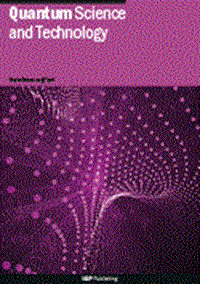将可信节点升级到 900 千米光纤中继链的要求
IF 5.6
2区 物理与天体物理
Q1 PHYSICS, MULTIDISCIPLINARY
引用次数: 0
摘要
我们对现实世界中连接德国波恩和柏林两座城市的光纤网格上的纠缠分布进行了数值研究。连接是通过一连串处理节点量子中继器实现的,跨度约 900 公里。它们的位置受到我们所考虑的光纤网格的限制,导致链路不对称。我们研究了最低硬件要求如何取决于目标应用以及链中中继器的数量。我们发现,盲量子计算与量子密钥分发的要求明显不同,前者所需的相干时间大约是后者的两倍半。此外,我们还观察到在使用不同数量的中继器时如何实现目标秘钥率的权衡:在中继器数量较多的情况下,以较高的速率生成的纠缠态质量相对较低,而在中继器数量较少的情况下,以较低的速率生成的纠缠态质量相对较高。为了获得研究结果,我们采用了一个广泛的模拟框架,该框架通过量子网络离散事件模拟器 NetSquid 实现。这些都与基于遗传算法的优化方法相结合,以确定最低硬件要求。本文章由计算机程序翻译,如有差异,请以英文原文为准。
Requirements for upgrading trusted nodes to a repeater chain over 900 km of optical fiber
We perform a numerical study of the distribution of entanglement on a real-world fiber grid connecting the German cities of Bonn and Berlin. The connection is realized using a chain of processing-node quantum repeaters spanning roughly 900 kilometers. Their placement is constrained by the fiber grid we consider, resulting in asymmetric links. We investigate how minimal hardware requirements depend on the target application, as well as on the number of repeaters in the chain. We find that requirements for blind quantum computing are markedly different than those for quantum key distribution, with the required coherence time being around two and a half times larger for the former. Further, we observe a trade-off regarding how target secret-key rates are achieved when using different numbers of repeaters: comparatively low-quality entangled states generated at a high rate are preferred for higher numbers of repeaters, whereas comparatively high-quality states generated at a lower rate are favored for lower numbers of repeaters. To obtain our results we employ an extensive simulation framework implemented using NetSquid, a discrete-event simulator for quantum networks. These are combined with an optimization methodology based on genetic algorithms to determine minimal hardware requirements.
求助全文
通过发布文献求助,成功后即可免费获取论文全文。
去求助
来源期刊

Quantum Science and Technology
Materials Science-Materials Science (miscellaneous)
CiteScore
11.20
自引率
3.00%
发文量
133
期刊介绍:
Driven by advances in technology and experimental capability, the last decade has seen the emergence of quantum technology: a new praxis for controlling the quantum world. It is now possible to engineer complex, multi-component systems that merge the once distinct fields of quantum optics and condensed matter physics.
Quantum Science and Technology is a new multidisciplinary, electronic-only journal, devoted to publishing research of the highest quality and impact covering theoretical and experimental advances in the fundamental science and application of all quantum-enabled technologies.
 求助内容:
求助内容: 应助结果提醒方式:
应助结果提醒方式:


